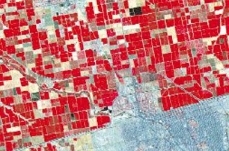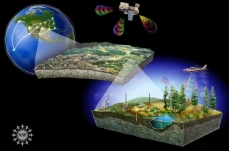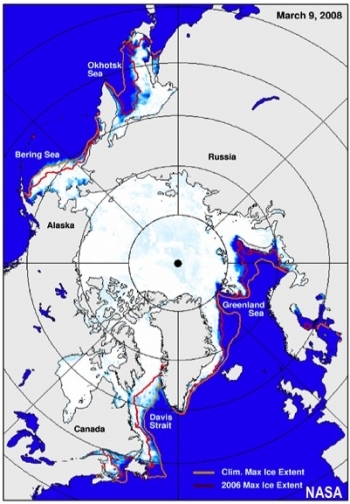Environmental Information (Environmental & Earth Science)
From The Encyclopedia of Earth
Environmental Information
Making information about the environment readily available to the public and others involves a range of issues, including:
- How facts are developed from underlying data, hypotheses, assumptions, models, and interpretations; and how they are developed under different types of review and quality control;
- Mechanisms for providing effective access to information and characterizing limitations placed on its use;
- Tools that allow one to visualize or interrelate information to gain a deeper or clearer understanding of an environmental issue in a particular situation or location; and
- Individuals, organizations and resources that contribute to making environmental information more useful or available to wider audiences.
Many important and or/technical aspects of data and information management are included under a subtopic of that name.
========
-
 Featured Article
Featured Article  Mining of Published Scientific ResearchA Scientific Gold Rush: Electronic Mining of Published Research The journal Science publishes an important paper on harvesting vast amounts of "metaknowledge" The... More »
Mining of Published Scientific ResearchA Scientific Gold Rush: Electronic Mining of Published Research The journal Science publishes an important paper on harvesting vast amounts of "metaknowledge" The... More »
-
 Featured Article
Featured Article  A Greener Future for our NationCultivating the Seeds of Knowledge: Growing a Greener Future for our Nation As the bitter chill of winter retreats, the vibrancy of spring beckons us outdoors reminding... More »
A Greener Future for our NationCultivating the Seeds of Knowledge: Growing a Greener Future for our Nation As the bitter chill of winter retreats, the vibrancy of spring beckons us outdoors reminding... More »
-
 Featured Article
Featured Article  National Center for Science and Engineering...National Center for Science and Engineering Statistics The National Science Foundation's National Center for Science and Engineering Statistics has new responsibilities... More »
National Center for Science and Engineering...National Center for Science and Engineering Statistics The National Science Foundation's National Center for Science and Engineering Statistics has new responsibilities... More »
-
 Featured Article
Featured Article  Phosphorus: Too Much or Too Little?Phosphorus: Too Much or Too Little Scientists and artists collaborate on accompanying works to address looming environmental issue Fertilizer is rarely an inspiration... More »
Phosphorus: Too Much or Too Little?Phosphorus: Too Much or Too Little Scientists and artists collaborate on accompanying works to address looming environmental issue Fertilizer is rarely an inspiration... More »
-
 Featured Article
Featured Article  National Health and Nutrition Examination...The National Health and Nutrition Examination Survey Introduction The National Health and Nutrition Examination Survey (NHANES) is a program of studies designed to... More »
National Health and Nutrition Examination...The National Health and Nutrition Examination Survey Introduction The National Health and Nutrition Examination Survey (NHANES) is a program of studies designed to... More »
-
 Featured Article
Featured Article  Plants and Healthy Indoor AirPoor indoor air quality has been linked to health problems. This article, written by Dr. Luz Claudio*, appeared first in Environmental Health Perspectives—the... More »
Plants and Healthy Indoor AirPoor indoor air quality has been linked to health problems. This article, written by Dr. Luz Claudio*, appeared first in Environmental Health Perspectives—the... More »
-
 Featured News Article
Featured News Article  "ShakeOut" Earthquake DrillsDrop! Cover! Hold On! "ShakeOut" Earthquake Drills Take Place This Week "ShakeOuts" to be held in California, Nevada, Guam, Oregon, Idaho, British... More »
"ShakeOut" Earthquake DrillsDrop! Cover! Hold On! "ShakeOut" Earthquake Drills Take Place This Week "ShakeOuts" to be held in California, Nevada, Guam, Oregon, Idaho, British... More »
-
 Featured Article
Featured Article  Mapping the environmentThis article, authored by Kellyn S. Betts, appeared first in Environmental Health Perspectives—the peer-reviewed, open access journal of the National Institute of... More »
Mapping the environmentThis article, authored by Kellyn S. Betts, appeared first in Environmental Health Perspectives—the peer-reviewed, open access journal of the National Institute of... More »
-
 Featured Article
Featured Article  National Ecological Observatory NetworkNational Ecological Observatory Network The National Ecological Observatory Network is a project sponsored by the National Science Foundation and managed under... More »
National Ecological Observatory NetworkNational Ecological Observatory Network The National Ecological Observatory Network is a project sponsored by the National Science Foundation and managed under... More »
Recently Updated
 Climate (Environmental Information) Last Updated on 2014-10-01 10:48:54 Climate is the typical pattern of conditions of the earth’s atmosphere over a given region, as defined by factors such as temperature, air pressure. humidity, precipitation, sunlight, cloudiness, and winds. The World Meteorological Organization defines climate as "the statistical description in terms of the mean and variability of relevant quantities over a period of time," where an appropriate period is typically at leastthirty years.Climate can be assessed at different, overlapping geographic regions. For example, Earth is thought to have a climate that is distinct from that of other planets, while different regions of Earth are also thought to have distinct climate types. Climate is often described as the "average" conditions; however, since daily and seasonal variability (including extremes) are critical determinants, using the term... More »
Climate (Environmental Information) Last Updated on 2014-10-01 10:48:54 Climate is the typical pattern of conditions of the earth’s atmosphere over a given region, as defined by factors such as temperature, air pressure. humidity, precipitation, sunlight, cloudiness, and winds. The World Meteorological Organization defines climate as "the statistical description in terms of the mean and variability of relevant quantities over a period of time," where an appropriate period is typically at leastthirty years.Climate can be assessed at different, overlapping geographic regions. For example, Earth is thought to have a climate that is distinct from that of other planets, while different regions of Earth are also thought to have distinct climate types. Climate is often described as the "average" conditions; however, since daily and seasonal variability (including extremes) are critical determinants, using the term... More »  Sustainable Society Index Last Updated on 2014-07-31 13:15:01 When we were looking for a suitable yardstick to measure the level of sustainability of a country a suitable instrument could not be found. Although the main existing indexes were examined we had to conclude that none of them seem to fit our needs completely. The main shortcomings are a limited definition of sustainability, a lack of transparency or high complexity and an absence of regular updates. For this reason, a new index – the Sustainable Society Index (SSI) – has been developed. The SSI integrates the most important aspects of sustainability and quality of life of a national society in a simple and transparent way. Consisting of only 22 indicators, grouped into 5 categories, it is based upon the definition of the Brundtland Commission, extended to the Brundtland+ definition by explicitly including the social aspects of human life. Using data from public sources,... More »
Sustainable Society Index Last Updated on 2014-07-31 13:15:01 When we were looking for a suitable yardstick to measure the level of sustainability of a country a suitable instrument could not be found. Although the main existing indexes were examined we had to conclude that none of them seem to fit our needs completely. The main shortcomings are a limited definition of sustainability, a lack of transparency or high complexity and an absence of regular updates. For this reason, a new index – the Sustainable Society Index (SSI) – has been developed. The SSI integrates the most important aspects of sustainability and quality of life of a national society in a simple and transparent way. Consisting of only 22 indicators, grouped into 5 categories, it is based upon the definition of the Brundtland Commission, extended to the Brundtland+ definition by explicitly including the social aspects of human life. Using data from public sources,... More »  Improving access to and use of earth science data Last Updated on 2013-10-22 23:34:26 USGS Helps Debut New Technology to Improve Access and Use of Earth Science Data Researchers investigating global issues now have an easy method for finding and using earth science data through a new technology developed by the Data Observation Network for Earth, or DataONE. Understanding broad and complex environmental issues, for example climate change, increasingly relies on the discovery and analysis of massive datasets. But the amount of collected data—from historical field notes to real-time satellite data—means that researchers are now faced with an onslaught of options to locate and integrate information relevant to the issue at hand. DataONE, a ten-institution team with several hundred Investigators, including researchers from the United States Geological Survey (USGS), is addressing this data dilemma with a number of cyberinfrastructure and... More »
Improving access to and use of earth science data Last Updated on 2013-10-22 23:34:26 USGS Helps Debut New Technology to Improve Access and Use of Earth Science Data Researchers investigating global issues now have an easy method for finding and using earth science data through a new technology developed by the Data Observation Network for Earth, or DataONE. Understanding broad and complex environmental issues, for example climate change, increasingly relies on the discovery and analysis of massive datasets. But the amount of collected data—from historical field notes to real-time satellite data—means that researchers are now faced with an onslaught of options to locate and integrate information relevant to the issue at hand. DataONE, a ten-institution team with several hundred Investigators, including researchers from the United States Geological Survey (USGS), is addressing this data dilemma with a number of cyberinfrastructure and... More »  Freeway proximity and autism? Last Updated on 2013-09-14 23:34:22 This study examined the association between autism and proximity of residence to freeways and major roadways during pregnancy and near the time of delivery, as a surrogate for air pollution exposure. This research article, written by Heather E. Volk, Irva Hertz-Picciotto, Lora Delwiche, Fred Lurmann, and Rob McConnell* appeared first in Environmental Health Perspectives—the peer-reviewed, open access journal of the National Institute of Environmental Health Sciences. The article is a verbatim version of the original and is not available for edits or additions by Encyclopedia of Earth editors or authors. Companion articles on the same topic that are editable may exist within the Encyclopedia of Earth. Residential Proximity to Freeways and Autism in the CHARGE Study Background: Little is known about environmental causes and contributing factors for autism. Basic science and... More »
Freeway proximity and autism? Last Updated on 2013-09-14 23:34:22 This study examined the association between autism and proximity of residence to freeways and major roadways during pregnancy and near the time of delivery, as a surrogate for air pollution exposure. This research article, written by Heather E. Volk, Irva Hertz-Picciotto, Lora Delwiche, Fred Lurmann, and Rob McConnell* appeared first in Environmental Health Perspectives—the peer-reviewed, open access journal of the National Institute of Environmental Health Sciences. The article is a verbatim version of the original and is not available for edits or additions by Encyclopedia of Earth editors or authors. Companion articles on the same topic that are editable may exist within the Encyclopedia of Earth. Residential Proximity to Freeways and Autism in the CHARGE Study Background: Little is known about environmental causes and contributing factors for autism. Basic science and... More »  Geophony, Biophony, and Anthrophony Last Updated on 2012-08-09 00:00:00 What do these words mean? Biophony is the melodic sound created by such organisms as frogs and birds; geophony, the composition of non-biological sounds like wind, rain and thunder; and anthrophony, the conglomeration of noise spawned by human activity. Studying Nature's Rhythms: Soundscape Ecologists Spawn New Field The following Discovery article is part is part four in a series on the National Science Foundation's Science, Engineering and Education for Sustainability (SEES) investment. Visit parts one, two, three, five, six and seven in this series. Listen to biophony, geophony, anthrophony: the 'music' of Planet Earth The following is part four in a series on the National Science Foundation's Science, Engineering and Education for Sustainability (SEES) investment. Visit parts one, two, three, five, six and seven in this series. Geophony.... More »
Geophony, Biophony, and Anthrophony Last Updated on 2012-08-09 00:00:00 What do these words mean? Biophony is the melodic sound created by such organisms as frogs and birds; geophony, the composition of non-biological sounds like wind, rain and thunder; and anthrophony, the conglomeration of noise spawned by human activity. Studying Nature's Rhythms: Soundscape Ecologists Spawn New Field The following Discovery article is part is part four in a series on the National Science Foundation's Science, Engineering and Education for Sustainability (SEES) investment. Visit parts one, two, three, five, six and seven in this series. Listen to biophony, geophony, anthrophony: the 'music' of Planet Earth The following is part four in a series on the National Science Foundation's Science, Engineering and Education for Sustainability (SEES) investment. Visit parts one, two, three, five, six and seven in this series. Geophony.... More » 